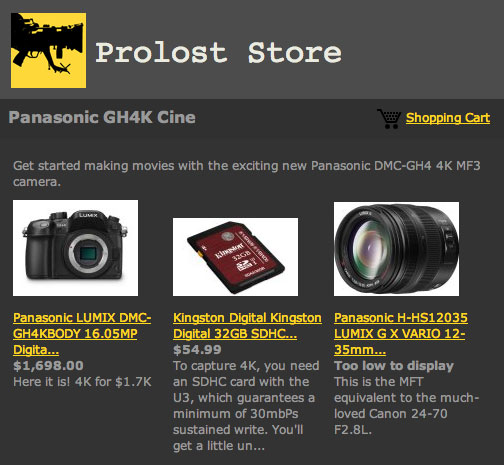
As promised, Panasonic today announced the video-equipped successor to the DMC-G1, their Micro Four Thirds not-an-SLR that conspicuously lacked video. Called the DMC-GH1, it was the talk of Twitter today.
And deservedly so. As promised, it's all the juicy photography things the G1 was and more, plus HD video from a company with a terrific track record in that area that spans the high end to the proletariat. Panasonic, after all, brought 24p to the masses with the DVX100. Like Canon, they have long made terrific stills and video gear. Unlike Canon, it seems that Panasonic allows those divisions to talk to each other.
The GH1 is the first stills camera with video that reflects true attention to the video part. Remember that Panasonic not only brought us 24p DV, they also brought us HD on the desktop (even the laptop!) with their compressed-just-the-right-amount-for-today DVCPROHD format. Panasonic knows video, and that knowledge is reflected in the GH1. Its AVCHD formats are readily supported by the major video editing packages, and the press release proudly touts "a Creative Movie mode, which lets the user set the shutter speed and aperture manually to make even more impressive movies."
Manual settings. Finally, somebody swallowed the Obvious Pill.
Further evidence that Panasonic is a video company that makes a stills camera that shoots video: You can record until your card fills up. Autofocus works—the right way (smooth not fast). There's a flip-out LCD for shooting things other than your identical twin. There's a whole button just for shooting video. At any time. And it's red.
So a company well known for pioneering filmmaker-friendly camcorders and killer stills gear finally put the chocolate and the peanut butter into the awesomizer and hit frappé. What's to complain about?
Thanks for asking. First, as I said, Panasonic knows video. I don't even like to use the term video. When I first held my DVX100, I saw it as the first accessible Digital Cinema camera, not a video camera. Video is tapes and signals and pluge (pluge?) and vertical blanking. Digital cinema is pixels and fricking movies.
Panasonic's focus on capital-V video is evident in the GH1's 24p recording method. It encodes the true 1080p24 off the sensor into a 1080i60 stream, via 3:2 pulldown. That means it's recording redundant (bandwidth-wasting) information to the video file. It falls to you to remove the pulldown in post, adding numerous headaches and necessitating careful attention to avoid recompression.
AVCHD supports 1080p24—in fact, Panasonic's own HMC150 records it. Why did Panasonic force 3:2 pulldown (which is to 24p as stone tablets are to the Kindle 2) on the GH1? Maybe they were desperate to have something about their HD cameras be better than this little game changer. More on that in a bit.
Because while we're in the one-step-forward, two-steps-back department, we also have to talk about the lens. The GH1 comes with a kit lens that, like most kit lenses, goes the Microsoft route of doing everything poorly rather than doing one thing well. The LUMIX G VARIO HD 14-140mm/F4.0-5.8 ASPH./MEGA O.I.S. lens (yes, seriously) is mandatory with the GH1, and follows the kit lens mandate of being slow-as-heck in order to be lightweight, affordable, and provide a broad range of focal lengths.
Presumably we film folk are interested in the GH1 because of its big-ass sensor and the shallow depth of field that it portends. So how stoked are we going to be shooting at between f/4 and f/5.8? Not. So we'll be buying more cute little lenses and swapping them often. One step forward, two steps back.
It's funny how the badass little LX3 shows up its big brother in a few key ways. The LX3 shoots lightly-compressed 24p movies that are actually 24p. And its tiny little lens is f/2.0 at the wide end.
So the GH1 isn't perfect. What's to be excited about then?
Everything. Especially this:

The Micro Four Thirds sensor is almost as big as that of the RED One. It's nearly Super35 in size. It dwarfs the nearest prosumer video camera sensor size.
There is a camera coming this summer that has a sensor nearly as big as the RED one's, takes interchangeable lenses, and fits in the palm of your hand. It has full manual control, state-of-the art automatic features (not just face detection, face recognition), and shoots both 24p and 60p.
And it will cost less than $2,000 (rumored) with a lens.
Panasonic has the kintamas to make a stills camera that would make one think twice about buying a much more expensive HD video camera. From Panasonic.
And that is why I love them.
Remember the original (now dead) Scarlet? It's here in a couple of months, cheaper by a third, and has a bigger chip and swappable glass. If you don't mind a little compression.
Now we just gotta see some footage (uhm, I mean real footage, not this). Panasonic, if you're using those dual Venus Engine HD image processors to make that video right (downsampling rather than line-skipping or pixel-binning), you may just have made the ultimate camera for the DOF-obsessed Rebel.
Let the Subway Shorts commence!
 Tuesday, March 17, 2009 at 12:08PM
Tuesday, March 17, 2009 at 12:08PM 













